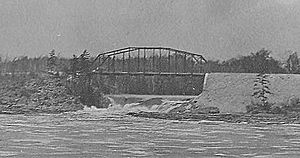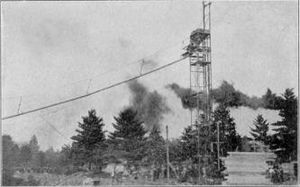Upper Twin Falls Bridge facts for kids
Quick facts for kids Upper Twin Falls Bridge |
|
|---|---|

Upper Twin Falls Bridge in 1911
|
|
| Coordinates | 45°52′39″N 88°04′43″W / 45.8775°N 88.0785°W |
| Crosses | Menominee River |
| Locale | Michigan–Wisconsin border |
| History | |
| Designer | M. W. Torkelson |
| Constructed by | Central States Bridge Company |
| Construction cost | $5,106 |
|
Upper Twin Falls Bridge
|
|
| Lua error in Module:Location_map at line 420: attempt to index field 'wikibase' (a nil value). | |
| Built | 1909–1910 |
| NRHP reference No. | 12001028 |
| Added to NRHP | December 12, 2012 |
The Upper Twin Falls Bridge is a historic bridge that crosses the Menominee River. This river forms part of the border between Michigan and Wisconsin. The bridge connects Breitung Township in Michigan with Florence County, Wisconsin in Wisconsin. It was finished in 1910. The bridge was built because a new dam was being constructed downstream, which would have flooded the old bridge.
In 1971, the Upper Twin Falls Bridge was closed to cars. It was later added to the National Register of Historic Places in December 2012. This means it is recognized as an important historical site.
Contents
What Kind of Bridge Is It?
The Upper Twin Falls Bridge is a special type of bridge called a camelback through-truss bridge. Imagine a bridge made of many triangles and straight bars, like a giant metal puzzle. This design helps the bridge be very strong.
- A truss bridge uses a framework of connected triangles to support the road.
- A through-truss means the road goes through the middle of the truss structure.
- A camelback truss has a top that looks like a camel's hump, with a curved or angled shape.
- It is also a single-span bridge, meaning it crosses the river with one continuous section.
This bridge is quite unique! It's the only one of its kind known in Michigan. There is one other similar bridge in Wisconsin, but it's not in its original spot. The bridge crosses the Menominee River about 4 miles (6.4 km) north of Iron Mountain, Michigan.
How the Bridge Was Built
Why Was the Bridge Needed?
In the early 1900s, a company called Peninsula Power Company planned to build a large dam. This dam, called the Twin Falls Power Dam, was going to be built on the Menominee River. Building the dam would create a big lake (a reservoir) behind it. An older bridge upstream would have been completely covered by this new lake. So, a new bridge was needed to replace it.
Building the New Bridge
The Upper Twin Falls Bridge was designed by M. W. Torkelson from Wisconsin. The actual building of the bridge happened between 1909 and 1910. It cost $5,106 to build. This cost was shared equally by Dickinson County in Michigan and Florence County in Wisconsin.
A person named Gilbert Vilas Carpenter oversaw the construction. The long dirt paths leading up to the bridge, called causeways, cost an extra $7,500. These were paid for by the Twin Falls Land Association. Dirt for the Wisconsin side was dug from a special pit and brought to the site on small trains. The dam that caused all this building was finally finished in 1912.
The Bridge Through the Years
Honoring Gilbert Carpenter
Sadly, Gilbert Carpenter passed away during World War I. He was on a ship that was attacked. To remember him, a special monument was put up at the north end of the bridge. This monument was dedicated on Memorial Day in 1923. Part of the money for the monument came from the Dickinson County Road Commission. A bronze plaque with his name on it was given by the Michigan State Highway Department.
Changes to Traffic and Ownership
In the early 1930s, important highways like US Highway 2 and US Highway 141 used the Upper Twin Falls Bridge. But in 1934, a brand new bridge was built about a mile downstream. US 2 and US 141 were then moved to this new bridge.
Because of this, the Upper Twin Falls Bridge was closed to cars in September 1971. The bridge and its connecting roads were then given to the Dickinson County Road Commission and the Town of Florence. Some experts believe the bridge survived because it was no longer used by busy highways.
Around the year 2000, officials started thinking about what to do with the bridge. They considered taking it down or fixing it up. However, taking it down was too expensive. Some people with pontoon boats wanted it removed because their boats were too tall to go under it.
Becoming a Historic Place
In 2012, people started the process to get the bridge listed on the National Register of Historic Places. This would help protect it and possibly get money for its repair. Both Michigan and Wisconsin historical groups reviewed the nomination and supported it.
Finally, on December 12, 2012, the Upper Twin Falls Bridge was officially added to the National Register of Historic Places. It was the first site ever nominated by both Michigan and Wisconsin together! People hope that this listing will help get funding to restore the bridge.
Even with the historical listing, the bridge is not expected to reopen for car traffic.
Images for kids




